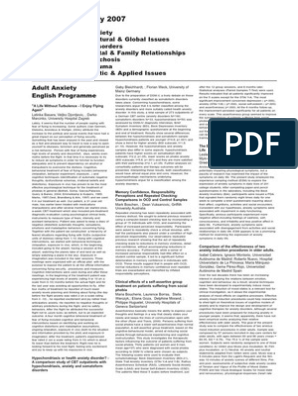100% found this document useful (1 vote)
847 views24 pagesOCD Notes Psych-Reads DR - Manish
The document discusses obsessive-compulsive disorder (OCD) and related topics in three parts:
1. It defines obsessions and compulsions, describes their various forms and contents, and discusses phenomena like obsessive slowness and the "just right" phenomenon in OCD.
2. It outlines Jaspers' five essential characteristics of obsessional symptoms and describes different forms of compulsions.
3. It lists several scales used to measure OCD symptom severity, self-reported OCD symptoms, impairment due to OCD, family accommodation of OCD behaviors, and insight in OCD patients.
Uploaded by
Priyanka KoundinyaCopyright
© © All Rights Reserved
We take content rights seriously. If you suspect this is your content, claim it here.
Available Formats
Download as PDF, TXT or read online on Scribd
100% found this document useful (1 vote)
847 views24 pagesOCD Notes Psych-Reads DR - Manish
The document discusses obsessive-compulsive disorder (OCD) and related topics in three parts:
1. It defines obsessions and compulsions, describes their various forms and contents, and discusses phenomena like obsessive slowness and the "just right" phenomenon in OCD.
2. It outlines Jaspers' five essential characteristics of obsessional symptoms and describes different forms of compulsions.
3. It lists several scales used to measure OCD symptom severity, self-reported OCD symptoms, impairment due to OCD, family accommodation of OCD behaviors, and insight in OCD patients.
Uploaded by
Priyanka KoundinyaCopyright
© © All Rights Reserved
We take content rights seriously. If you suspect this is your content, claim it here.
Available Formats
Download as PDF, TXT or read online on Scribd
/ 24
























































































